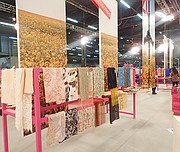Première Vision New York Looks Ahead to the Future of Fashion
Trade Shows
As of Thursday, January 24, 2019
NEW YORK—Première Vision New York offered fashion professionals an inside glimpse into the colors and trends that will imbue the Spring/Summer 2020 season in textiles and fashion.
The trade show, which this year ran Jan. 14–16 at Pier 94, provides the opportunity to meet a curated international group of textile and leather producers, accessories companies, design studios and manufacturers. “Première Vision is for the buyer, for the designer, for the creative people,” said Guglielmo Olearo, international exhibitions director, “because we primarily focus on the materials.”
Key among the show’s selling points is its expertly prepared color range, presenting 21 colors delineated by Première Vision as key for the Spring/Summer 2020 season.
Associate Fashion Director Julie Greux presented an overview of the season’s colors in a Trends Tasting seminar. At another seminar, she highlighted top design and product trends for the season, including sophisticated rawness; enhanced naturals; personalization, exemplified in offbeat, misleading tones; and voluptuous fluidity, with designs in pearly shine, wet reflections, iridescent yarn, firefly and sandfish effects; plus watercolor patterns “reminiscent of Monet’s Water Lilies,” Greux said.
She noted that a hydrangea design is expected to be a breakout bestseller for Spring/Summer 2020. Another noted theme was a gleeful mobility, focusing on lightness in fabric and tone, graceful shivering designs and spontaneous graphics.
Several design styles highlighted in the seminar—including cutout botanicals and color blocks with a new way of graduating colors—were on display at the booth of Brooklyn, N.Y.–based Moonshake Studio, a relative industry newbie launched in January 2018. “It’s all about textures and perspectives,” said Marika Kandelaki, the brand’s artist and creative director.
In Première Vision’s Smart Creation program, sustainable-development products were showcased, along with a Smart Wardrobe with finished outfits by fashion brands. The event also featured Smart Talks on sustainability initiatives, future fashion, fashion technology and 3-D printing.
High-tech textiles exhibited at the show included Kyorene, a fiber made from graphene, a thin layer of graphite first isolated in 2004 at the University of Manchester in England. “Most of the development of graphene has not been in textiles but in solar panels, cell phones and hundreds of other applications,” said Matt Reid, director of sales for Kyorene maker Graphene One. But expanding into textiles was a natural progression, Reid said, with enticing benefits including UV absorption and body-thermal regulation as well as mosquito and mite repellence. “We thought, these are really good properties for fiber.”
The Japanese company Asahi Kasei showcased its eco-fiber Bemberg, made of Cupro, a biodegradable cotton byproduct and vegan silk alternative that has been around since 1931 and is often used as luxury suit-jacket liner material.
Portuguese brand Lemar exhibited new eco-friendly offerings with fabrics incorporating two recycled fibers—Seaqual, made from plastic captured from the ocean off the Spanish coast, and Newlife, made from plastic bottles recovered on land in Italy. “We love to develop new things,” said Lemar Chief Executive Manuela Araújo. She said Lemar offered eco-friendly products a decade ago, but customer interest had waned until recently. “Now people are afraid for our planet,” she said.
Turkey, the largest textile producer in Europe, had a strong presence at the show with 29 exhibitors. “Turkey is quite competitive nowadays,” said Ishak Aydin Öztürk, general manager oftheTurkish fashion-knit company Ekoten Fabrics. He noted that although it is still important to attend trade shows, the seasonals can’t quite match the pace of fast fashion and the need for new collections every few weeks. “Everything in Europe is very fast,” he said. “Now more U.S. companies are switching to this philosophy.”
Indeed, traditional American brands have been influenced by fast-fashion brands such as Zara and H&M, Olearo said. Also, fashion is not the No. 1 budget item for most families. “Consumers are more interested in going out, well-being and electronics,” he said. “Fashion has been overcome. In the United States, the largest brands are still struggling to recover.”
Also, consumers want to know about the origins and production processes that go into their products. “Customers want to know where the product is coming from, who is producing it, and they want an affordable price because their income hasn’t increased a lot,” Olearo said. “The industry is trying to find the right model for the future. Brands are trying to reinvent themselves and find a new formula to be successful.”

